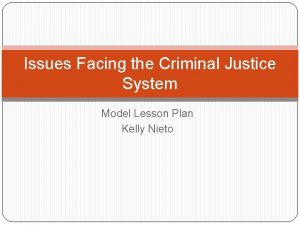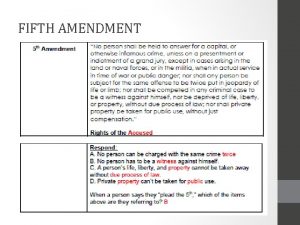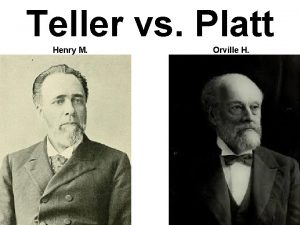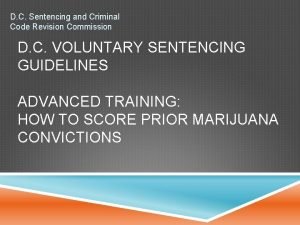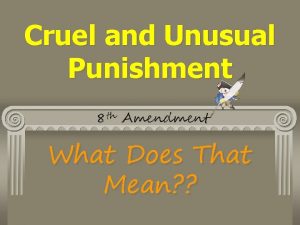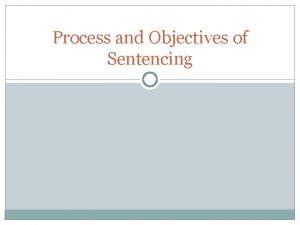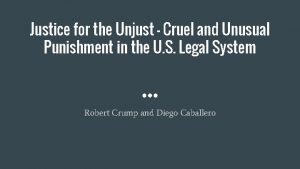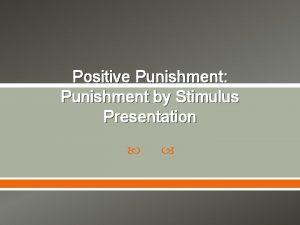Sentencing Eighth Amendment prevents cruel and unusual punishment













- Slides: 13

Sentencing Eighth Amendment prevents cruel and unusual punishment.

Sentencing and Proportions � Would a prison sentence of 25 years to life for stealing a slice of pizza be thrown out as a violation of the 8 th amendment? � Would it matter if it was a repeat offender? � In 1983, Supreme Court says yes. A South Dakota court sentenced a man to life in prison for passing a bad $100 check. It adhered to a law that allowed a sentence of life without parole for anyone convicted of a fourth felony. Supreme Court (5 -4) ruled that the sentence must be proportionate to the crime committed.

�Factors that determine if a sentence is proportionate to the crime �Compare the � 1. seriousness of the crime to severity of sentence � 2. kinds of sentences other criminals were given for same crime � 3. kinds of sentences given in other jurisdictions

Controversy in 1991 – Supreme Court falls away from proportion rule �An Air Force veteran with no priors is convicted of possessing 672 grams of cocaine �Receives a life sentence with no parole under a mandatory Michigan-sentencing law �This sentence is comparable to what a criminal convicted of first-degree murder would receive �In Ohio, the veteran would have received 5 -15 years �Supreme Court upholds sentence (5 -4) �Reasoning on page 236 -237 �Some judges thought it allowed the court too much power – Ewing v. CA and Lockyer v.

California’s Three Strike Rule � Trying to keep repeat offenders off the streets � Constitution does not adopt any one kind of punishment – Justice Sandra Day O’Connor � Cannot look only at the seriousness of the crime but must also consider prior records and public safety � All of these cases end up with justices that agree in decision but often disagree in reasoning

Federal Sentencing � 1980 – federal prisons hold 24, 000 people � 2009 – fed prisons hold over 200, 000 � 50 % are drug offenders � African American males went from 30% in 1987 to almost 40% in 2009 (35% of jails and state prisons) � https: //www. bop. gov/about/statistics_inmate_rac e. jsp � Crack vs. Cocaine � Crack cocaine first hit in the 1980 s, is smoked, and produces intense high > cheaper and led to gangs fighting for control of certain streets (turf wars) � Crack babies, drive-by shootings, death of Len Bias

Anti-Drug Abuse Acts of 1986 and 1988 � Created Office of National Drug Control Policy, whose director plans nation’s strategy to deal with drugs � Set harsh penalties for dealers in cocaine � Mandatory sentence of minimum 10 years without parole for any dealing 5, 000 grams or more. Those dealing 500 grams receive minimum of 5 years � Possession of 5 grams is the same 5 year sentence � No one objected that it would mostly affect blacks because they preferred crack due to its lower price � Police concentrated on inner-city neighborhoods, but it was difficult to track white dealers because they usually met indoors in various neighborhoods

� Led to more African American arrests (more than 80% dealers sentenced were black) � 1980 s – sentence lengths averaged same for whites and blacks � 1995 – blacks serving 40% longer sentences � Fairness – Should crack and powder cocaine be punished differently? � Both cocaine and powder can easily be turned into crack � If eggs were illegal, equivalent laws would punish omelets 100 times more severely than raw eggs –Criminologist Jerome Skolnick

Punishment values � Small time crack dealers are punished just like higherlevel cocaine dealers � 500 grams of powder cocaine produces 2500 to 5000 doses with a street value of $32, 500 to $50, 000 � 5 grams of crack cocaine produces 10 to 50 doses and is worth $225 to $750 >>> punished the same as above � Other critics argue that all drugs bring violence, and powder and crack cocaine are comparable (Miami 1980 s = powder) � Argue that violence has died down since early turf disputes � Others argue the laws are racist � Whites commit the most drug crimes, but blacks get the most

Supporters � Argue that crack is far more addictive than powder cocaine due to the intense high and manner of consumption � Crack addicts often commit other crimes to support their habits � Women give birth to babies who are addicted to crack, among other problems and defects � Lower cost makes it more attractive and addictive properties make it more likely to spread, which = a greater threat than powder � Some who believe laws are misguided argue against racism because they were not passed with racist intent � “There’s a difference between something being mistaken and counterproductive and something being racist … [T]he war on drugs may well be counterproductive, but no[t] … racist. ” – Harvard Law Professor Randall Kennedy

� Defendants have challenged the laws in federal appeals courts, but courts have not overturned any sentences, and the Supreme Court has declined to hear any of them. Challenges are based on � 1. the 100: 1 ratio of powder v. cocaine sentencing denies African Americans equal protection (14 th Am guarantees equal protection) � Due to protecting the public against a cheap drug, laws pass the rational basis test and are not found to have been passed based on discrimination � 2. Violation of due process because they are the same drug � Some � 3. say they are different; others specify different uses and effects Violation of cruel and unusual punishment � No, because higher amounts cause more harm

� Some courts have gotten in trouble for only prosecuting cases with African American defendants � These cases are dismissed � In 1995, the US Sentencing Commission recommended the ratio of 100: 1 be altered to 1: 1 and enhancements allotted to drug deals that involved weapons and violence � Congress refused until 2010 when they lowered the ratio to 18: 1 (28 g of crack = 5 years and 280 g = 10 years) � no change for powder, but did get rid of mandatory 1 st offense 5 year sentence

Debate continues � Critics believe the 2010 change is a good step � Supporters believe it will lead to a return to the 1980 s violence � In 2011, 12, 000 prisoners received reductions in their sentences
 Cruel cruel
Cruel cruel Eighth amendment excessive bail
Eighth amendment excessive bail Criminal justice lesson
Criminal justice lesson What's the 5th amendment
What's the 5th amendment Platt amendment vs teller amendment
Platt amendment vs teller amendment Alicia and i talking on edna's steps
Alicia and i talking on edna's steps The sentencing of bill thomas
The sentencing of bill thomas Virginia probation violation sentencing guidelines
Virginia probation violation sentencing guidelines Indeterminate sentencing juvenile
Indeterminate sentencing juvenile Dc sentencing commission
Dc sentencing commission Community alternative sentencing center
Community alternative sentencing center 6 word memoir for athletes
6 word memoir for athletes Predagogical
Predagogical Happy loman character analysis
Happy loman character analysis


